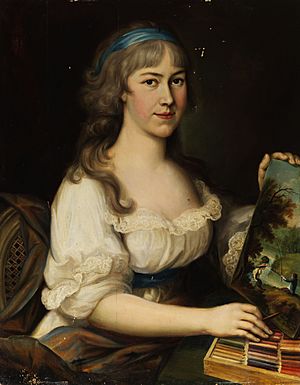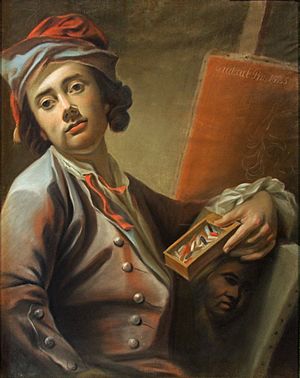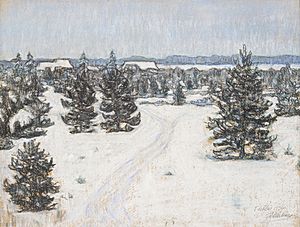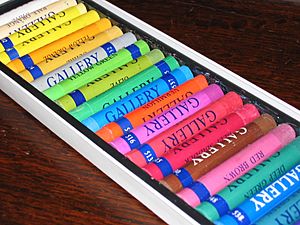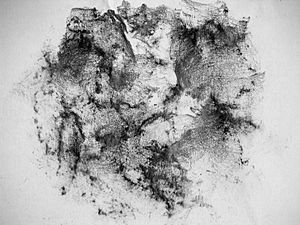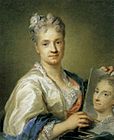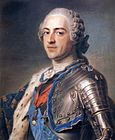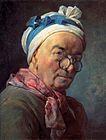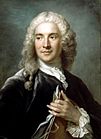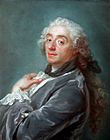Pastel facts for kids
A pastel is a special art stick made from pure colored powder, called pigment, mixed with a small amount of binder. The binder is a clear, neutral substance that holds the powder together. Pastels create colors that look very much like the natural dry pigments themselves.
Artists have used pastels since the Renaissance period. They became very popular in the 1700s, with many famous artists choosing pastels as their main art material.
When you make art with pastels, the artwork is also called a pastel. You might hear it called a pastel drawing or pastel painting. To "pastel" means to create art using these sticks. The word "pastel" can also describe pale colors, like "pastel pink."
Contents
Types of Pastels
Pastel sticks are made from pure powdered pigment and a binder. How a pastel stick feels and works depends on the type of pastel. It also depends on the amount and kind of binder used. Different companies make pastels in slightly different ways.
Dry pastels have often used binders like gum arabic and gum tragacanth. In the 1900s, methyl cellulose became another popular binder. Sometimes, chalk or gypsum is added too. Dry pastels come in different levels of hardness. Softer pastels are usually wrapped in paper to protect them. Some brands even add pumice to the binder. This helps the pastel stick better to the paper.
Here are the main types of dry pastels:
- Soft Pastels: These are the most common type. They have a lot of pigment and less binder. This makes their colors very bright. You can easily smudge and blend soft pastels. However, they create more dust. Finished soft pastel drawings need protection. You can frame them under glass or spray them with a special fixative. Hairspray can also work, but be careful. Fixatives might change the color or texture of your art. White chalk is sometimes added to make pale, bright colors.
- Pan Pastels: These pastels have very little binder. They come in flat, compact pans, like makeup. You apply them with special soft sponge tools. No liquid is needed with these. Pan pastels were invented in the 2000s. You can use them for a whole painting or mix them with soft and hard pastel sticks.
- Hard Pastels: These have more binder and less pigment. They are firm and great for drawing fine details. You can use them with other pastels for outlines or small accents. Artists often use hard pastels for the first sketch of a drawing. Their colors are not as bright as soft pastels. They also come in fewer color choices.
- Pastel Pencils: These are pencils with a pastel lead inside. They are perfect for adding very fine details to your artwork.
Besides dry pastels, there are other types:
- Oil pastels: These pastels feel soft and buttery. They have very strong, intense colors. Oil pastels are dense and fill the paper's texture well. They are a bit harder to blend than soft pastels. The good news is they don't need a fixative spray. You can even spread them on your art surface by thinning them with turpentine.
- Water-soluble Pastels: These are like soft pastels but contain something that dissolves in water. This lets you thin out the colors with water. You can create smooth, see-through effects with a water wash. Water-soluble pastels come in a limited range of strong colors. They are easy to blend and mix because they become fluid with water. You can also create different color effects depending on how much water you use.
There's been some discussion in art groups about what counts as a "pastel." The Pastel Society in the UK, which is the oldest pastel society, says that pastels, oil pastels, charcoal, pencil, Conté, and Sanguine are all fine for their exhibitions. They seem to focus on "dry media," but the discussion continues!
How Pastels Are Made
To make hard and soft pastels, pigments are ground into a paste. This paste is mixed with water and a gum binder. Then, it's rolled or pressed into sticks. The word "pastel" comes from an old Latin word, pastellum, which meant "woad paste." Woad is a plant used to make blue dye. The French word pastel first appeared in 1662.
Most pastel brands offer different shades of a color. The original pigment is usually dark. To make lighter shades, they mix in different amounts of chalk. This is why the word "pastel" also means "pale color." You often hear this term in fashion or makeup.
When you draw with a pastel, the stick moves over a rough surface. It leaves color on the paper's texture, or "grain." This can be on special paper, sandboard, or canvas. If the whole surface is covered with pastel, it's called a pastel painting. If parts are still showing, it's a pastel sketch or drawing. Pastel paintings have a very high amount of pigment. This means they reflect light without getting darker. This allows for very bright and rich colors.
Surfaces for Pastel Art
Pastel art needs a surface that has some "tooth." This means it needs a slightly rough texture. The tooth helps the pastel stick to the surface. It also holds the pigment in place.
Some common surfaces for pastels include:
- Laid paper: Examples are Ingres or Canson Mi Teintes paper.
- Abrasive surfaces: These have a finely ground material on them. This could be pumice, marble dust, or rottenstone.
- Velour paper: This paper has a soft, fuzzy surface. It's great for soft pastels. It's made of synthetic fibers attached to acid-free backing.
Keeping Pastel Art Safe
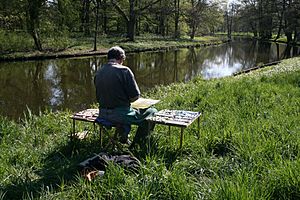
Pastel artworks can last a very long time if artists take proper care. This means:
- Using only pastels made with pigments that won't fade in light. Pigments in pastels are very sensitive to light. This is because they are not protected by a strong binder.
- Creating art on acid-free paper or other surfaces that will last. Some old artworks were made on fragile surfaces. These surfaces need extra protection under glass and away from light.
- Framing works correctly under glass. The glass should not touch the artwork. This protects the art from air, humidity, mold, and smudging.
- Some artists spray their finished pieces with a special fixative. This spray helps keep the pastel particles on the paper. However, it can't stop all smudging without making the bright colors look dull. Fixatives can also be harmful to breathe, so use them carefully. Hairspray is generally not recommended. It is not acid-free and can damage the artwork over time. Older fixatives can also change color eventually.
Because of these reasons, some pastel artists avoid fixatives. They only use them if the pastel surface can't hold any more color. The fixative can help the "tooth" of the paper return. Then, more pastel can be added. It's the surface's texture that holds the pastels, not the fixative. Rougher surfaces reduce the need for fixative. A modern fixative called SpectraFix is not harmful. It also doesn't dull pastel colors. However, it takes practice to use because it's a pump spray, not an aerosol. You can easily use too much, which might dissolve colors. It also takes longer to dry between layers.
Artists use Glassine paper to protect artworks when storing or moving them. Some good quality pastel paper books even have glassine sheets between the pages.
Pastel Art Techniques

Working with pastels can be tricky. You mix and blend colors right on your art surface. Unlike paint, you can't test colors on a palette first. Also, pastel mistakes are hard to cover up. It's a good idea to practice different techniques on small pieces of paper. This helps you get better control for bigger artworks.
Pastels share some techniques with painting. These include blending colors, using masks, building up layers, and adding highlights. Some techniques are also used with charcoal or pencil. Examples are hatching (drawing parallel lines) and crosshatching (drawing crossed lines). Other techniques are unique to pastels.
Here are some pastel techniques:
- Colored Grounds: Using a colored paper or surface. This can soften the pastel colors or create a nice contrast.
- Dry Wash: Covering a large area using the broad side of the pastel stick. You can use a cotton ball, paper towel, or brush to spread the color smoothly.
- Erasure: Lifting pigment from an area. You can use a kneaded eraser or other tools.
- Frottage: Placing paper over a textured surface and rubbing pastel over it. This picks up the texture.
- Impasto: Applying pastel very thickly. This creates a noticeable texture or raised surface on the artwork.
- Scumbling: Applying a thin, broken layer of color over another color. This lets the color underneath show through.
- Sgraffito: Scratching through a layer of pastel to reveal the color underneath.
- Stippling: Creating an image using many small dots of color.
- Textured Grounds: Using paper with a rough or smooth texture. This creates different effects in the artwork.
Safety When Using Pastels
Pastels are a dry art material and can create a lot of dust. This dust might irritate your nose or throat. More importantly, pastels use the same pigments as paints. Some of these pigments can be harmful if not handled properly. For example, some bright yellow, orange, and red colors contain cadmium. It's important to be careful with such pigments.
Because of this, many modern pastels use safer substitutes for pigments like cadmium or chromium. They still keep the traditional color names. Always wash your hands after using pastels, especially before eating. Avoid breathing in the dust. You can wear a mask if you are working with a lot of pastels.
Pastel Art in History
Pastels were first made in the 1400s. Leonardo da Vinci even mentioned them! He learned about pastels from a French artist named Jean Perréal in 1499. In the 1500s, artists like Federico Barocci sometimes used pastels for practice drawings. Joseph Vivien was the first French artist to focus on pastel portraits.
In the 1700s, pastels became popular for portraits. Sometimes, artists mixed them with gouache (a type of opaque watercolor). Famous pastel artists from this time include Jean-Baptiste Perronneau, Maurice Quentin de La Tour, and Rosalba Carriera. Jean-Baptiste-Siméon Chardin made beautiful pastel still life paintings and portraits. The Swiss-French artist Jean-Étienne Liotard also created amazing pastel works. In England, John Russell was a top pastel artist. In early America, John Singleton Copley sometimes used pastels for portraits.
After the French Revolution, pastels were less popular in France. They were seen as old-fashioned. But by the mid-1800s, French artists like Eugène Delacroix and Jean-François Millet started using pastels again. Édouard Manet painted many pastel portraits on canvas, which was unusual. Edgar Degas was a true innovator with pastels. After 1885, pastels became his main art form. He used them with great energy. Odilon Redon also created many pastel artworks.
Around 1880, James Abbott McNeill Whistler made many pastels, especially of Venice. This helped make pastels more popular in the United States. He showed how just a few strokes could capture a place or feeling. Mary Cassatt, an American artist living in France, introduced pastels and the Impressionist style to her friends in America.
The Metropolitan Museum of Art says that Mary Cassatt used pastels in a very artistic way. She learned from Edgar Degas. She beautifully captured family moments, like in her painting Mother Playing with Child.
In the eastern United States, the Society of Painters in Pastel was started in 1883. William Merritt Chase and Robert Blum were among its founders. In 1910, a group called The Pastellists was formed in New York. It included artists like Leon Dabo and Everett Shinn. On the West Coast, the artist and teacher Pedro Joseph de Lemos helped make pastels popular. He wrote articles about "painting" with pastels starting in 1919. He even suggested using special optics for "night sketches." His night scenes were often called "dreamscapes" and were influenced by French Symbolism.
Many modern artists like pastels because of their wide range of bright colors. Some notable modern artists who used pastels a lot include Fernando Botero, Francesco Clemente, Daniel Greene, Wolf Kahn, and R. B. Kitaj.
Pastels in Art
-
Rosalba Carriera, Self-portrait holding a portrait of her sister, 1715, pastel on paper; Galleria degli Uffizi, Florence
-
Maurice Quentin de La Tour, a bravura pastel portrait of Louis XV, 1748
-
Jean-Baptiste-Siméon Chardin. Self Portrait, 1771, pastel on paper, The Louvre
-
Édouard Manet, Madame Michel-Lévy, 1882, pastel on canvas, National Gallery of Art
-
James Abbott McNeill Whistler, Venetian Scene, 1879, pastel on paper
-
Odilon Redon, Baronne de Domecy, c. 1900, pastel and graphite on light brown laid paper, J. Paul Getty Museum
-
François Boucher depicted by Gustav Lundberg
-
Mary Cassatt, Sleepy Baby, 1910
-
Adolf Hirémy-Hirschl, Portrait of a Young Woman, c. 1915, pastel on orange paper, Art Institute of Chicago
Images for kids
-
William Merritt Chase, Study of Flesh Color and Gold, 1888, National Gallery of Art, NGA 103252
See also
 In Spanish: Pastel (técnica) para niños
In Spanish: Pastel (técnica) para niños


